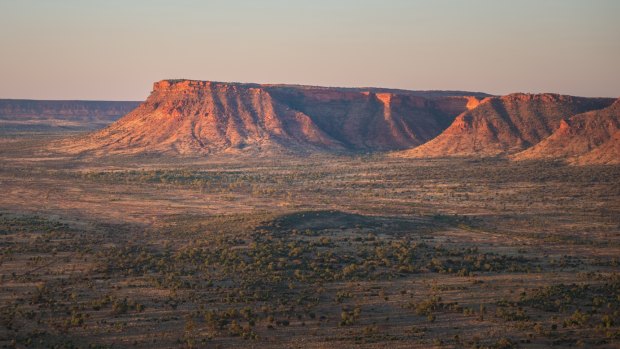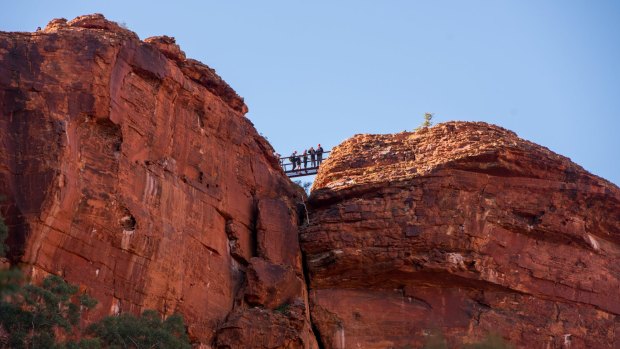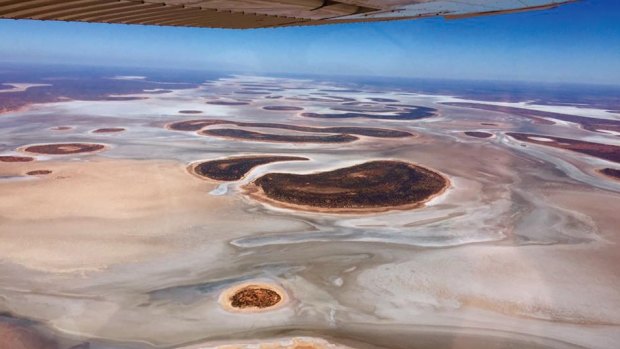This was published 5 years ago
Kings Canyon Northern Territory: One of Australia's best outback walks
By Andrew Bain

Kings Canyon.Credit: Matt Glastonbury
In the biblical Garden of Eden there were apples, but in the Garden of Eden inside Kings Canyon, everything is oranges. The canyon's iron-stained cliffs glow as brightly as flames, and their reflection is stencilled in orange across the dark pool of water at their base.
It's early morning and I'm halfway around a trail that's often described as one of Australia's best day walks, circuiting the rim of the Northern Territory's Kings Canyon and dipping briefly into this Garden of Eden inside the canyon.
The sun is still low, and the heat is already high, but inside the Garden of Eden the riverbanks are lush, damp and bristling with cycads, a relict, fern-like plant that existed with the dinosaurs. The song of a grey shrike thrush lilts through the "garden". It's the very definition of a desert oasis.

Kings Canyon Resort offers guests a guided walk on the canyon rim trail.
Like most visitors, I've come to Kings Canyon, in Watarrka National Park, for just a short time, but unlike most, it's taken me little time to get here. My visit is part of a new Overnight Delight package offered by Kings Canyon Resort, which includes charter flights to and from Uluru, a night at the resort, an Aboriginal cultural tour and a guided walk on the canyon rim trail.
From Uluru, it's little more than 30 minutes in a five-seater plane to the dusty airstrip at Kings Creek Station. From 2000 metres above the desert, the red sands of central Australia are like a dot painting of spinifex rings, and the saltpan of Lake Amadeus, the Northern Territory's largest salt lake, leaks to the horizon like a paint spill.
Kings Creek Station is the sort of airstrip at which you need to close the gate as you leave to keep camels off the runway. With the gate latched behind us, we drive west along the foot of the George Gill Range, the single bump in the landscape as far as the eye can see.

Flying over the Northern Territory with Kings Canyon Air Charters.
This range's escarpment forms an almost unbroken line of rock levitating above the desert, but when it does break open, it does so spectacularly, becoming the immense chasm of Kings Canyon.
There are several walks in the vicinity of the canyon, but the rim trail is the headline act. This six-kilometre loop walk begins at the mouth of the canyon, 10 minutes' drive from the resort. In the faint light of approaching dawn, we set out walking along Kings Creek, the dry waterway that somehow, over time, carved this enormous rift in the sandstone.
"I'm biased but I think this is one of the best walks in the world," says local guide Marcus before we begin the climb known locally as Heart Attack Hill – a rock staircase of 400 steps from the floor of the canyon to the rim.
This morning it's a climb into light as the rising sun begins to illuminate the slopes, and quickly we're standing atop the canyon's 100-metre-high walls, with the relentless red desert stretching off to a distant horizon.
It's the sort of scene that inspired explorer Ernest Giles to write of Kings Canyon in 1872, "could it be transported to any civilised land, its springs, glens, gorges, ferns, zamias (cycads) and flowers would charm the eyes and hearts of toil-worn men who are condemned to live and die in crowded towns".
The climb tops out near a narrow V-shaped break in the rock. Popular culture has transformed this notch into the canyon's most famous landmark. Since featuring in The Adventures of Priscilla Queen of the Desert, the notch has become known as Priscilla's Crack. It's also a portal of sorts, because as I step through it I'm entering the Lost City, where a crowd of sandstone domes atop the canyon rim creates a scale-model version of the Bungle Bungles in Western Australia.
Among the Lost City domes, a side track detours 300 metres to Cotterill's Lookout, perched atop one of the cliff-edge domes and looking straight across to the canyon's south wall, which appears as smooth and polished as the panels of a showroom car.
The lookout also provides a view through the mouth of the gorge and across the eternity of the desert. From where I stand, it's 1800 kilometres due west to the next town – Carnarvon on the West Australian coast – and yet the view is so vast it's tempting to believe I can almost see Carnarvon.
From here, the walk descends on wooden stairways into the Garden of Eden, before climbing out again and swinging back to the gorge entrance atop the precipitous south wall. Three hours after setting out, we're back.
To so many visitors, this rim walk is the extent of their Kings Canyon curiosity, but there's more here than rocks and rifts.
"I think that if you come out here and you only have time to do one thing, forget the rim walk," one staff member at the Kings Canyon Resort tells me. "Go to Karrke. I've never had anyone go to Karrke and not say it's the best Aboriginal cultural experience they've ever had."
Karrke (an Indigenous name for the western bowerbird) is a cultural tour run by Aboriginal couple Christine Breaden and Peter Abbott from their home in the community of Wanmarra – population 10 – at the edge of Watarrka National Park.
Christine is a Luritja woman, one of the traditional owners of the area, and for the next hour we're guided through a series of stations – many of them beneath shade cloth to dull the desert heat – on a step-by-step journey through Aboriginal existence and survival in the desert. There are short talks on grinding stones, bush tucker, bush medicine, art, jewellery, ochres, weaponry and musical instruments.
It's a compact circuit through culture, as Breaden and Abbott give erudite explanations of bush practices and beliefs, along the way debunking a couple of myths.
"This is a non-returning boomerang," Abbott says, holding up a weapon with an unfamiliar shape. "In central desert regions we don't use didgeridoos or returning boomerangs. They are more used in coastal areas."
Nor is the next station one of tradition. Here, Breaden unrolls a dot painting – representing a week of her work – explaining that this most familiar form of Aboriginal art only began in the 1960s. Before that, rock art, petroglyphs and drawings in the sand had been the traditional way for thousands of years.
"Dot paintings are a great modern way for us to pass information to young people," she explains.
This particular painting is of food – witchetty grubs – and as Breaden speaks, she pulls from beside her the root of a witchetty bush, peeling it back to reveal a plump white grub.
"Five or six of these grubs is what an adult would usually eat," Abbott says, explaining that the grubs can actually be found in nine different tree species, each of which provides the grub with a distinct and different flavour.
"A grub from an Acacia kempeana (witchetty bush) tastes like a mix of melted butter, popcorn, corn and egg."
As Abbott talks, Breaden rakes back a patch of sand and drops the grub onto hot coals buried beneath. Afternoon tea is served.
FIVE MORE CANYON WALKS
KAIBAB TRAIL
Begin on one rim of the Grand Canyon, descend to the Colorado River and make the long, steep climb out to the other rim.
FISH RIVER CANYON
Billed as the world's second-largest canyon, slicing through southern Namibia. A five-day trail traverses about half of its 160-kilometre length. Open May to September only.
GARGANTA DEL CARES
A day-long hike through the spectacular 1500-metre-deep gash of the Cares Gorge through Spain's Picos de Europa mountains.
TIGER LEAPING GORGE
Take the high road or the low road through China's wildly named canyon; allow about two days.
GRAND CANYON TRACK
A half-day walk through NSW's own Grand Canyon, a mystical slot canyon in the Blue Mountains.
TRIP NOTES
Andrew Bain travelled as a guest of Kings Canyon Resort and Tourism NT.
MORE
FLY
Virgin Australia and Jetstar fly direct to Uluru from Sydney; Jetstar also flies direct from Melbourne. See virginaustralia.com jetstar.com
STAY
Kings Canyon Resort's Overnight Delight package begins with a charter flight from Uluru to Kings Creek Station. It includes a guided rim walk, Karrke tour and a night in a standard or deluxe spa room at the resort, with prices starting at $715/1150 for a single/double. See kingscanyonresort.com.au karrke.com.au
Sign up for the Traveller Deals newsletter
Get exclusive travel deals delivered straight to your inbox. Sign up now.